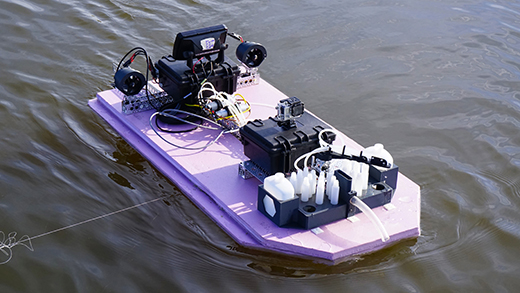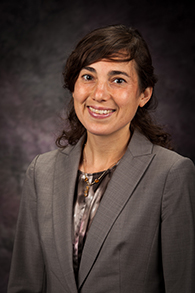K-State team receives USGS grant to study management of harmful algae blooms affecting freshwater systems
Wednesday, April 21, 2021

Kansas State University researchers are developing a robotic monitoring platform to collect water samples and measure lake characteristics that may drive formation of harmful cyanobacteria blooms. | Download this photo.
MANHATTAN — Harmful cyanobacteria blooms, also known as cyanoHABs or blue-green algae, are an emerging challenge to managing reservoirs and other freshwater systems in Kansas and across the globe because of the myriad of ecological, economic and human health issues they cause.
To address this concern, a Kansas State University research team is developing novel mobile monitoring platforms to better understand spatial dynamics of cyanoHABs. The team will then use the data to couple mechanistic and machine-learning models to improve cyanoHAB prediction.
Trisha Moore, associate professor and Peggy and Gary Edwards Cornerstone teaching scholar in the Carl and Melinda Helwig Department of Biological and Agricultural Engineering, will lead the three-year project, "Integrated data science — mechanistic modeling framework to predict cyanoHABS in contrasting freshwater systems." The project has been funded for $249,746 by the U.S. Department of Interior's U.S. Geological Survey, or USGS, program.
Through collaboration with USGS water scientists, Moore and her K-State colleagues — Aleksey Sheshukov, associate professor, and Daniel Flippo, associate professor and Patrick Wilburn Keystone research scholar, both from the biological and agricultural engineering department; and Lior Shamir, associate professor and Nick Chong Keystone research faculty scholar in the computer science department — will work in bodies of water in Kansas and New York to test transferability of the models across very different freshwater systems.
"Our aim is to advance understanding of the complex environmental interactions under which cyanoHABs develop and persist as well as to provide tools to help lake managers better monitor and forecast these blooms," Moore said. "CyanoHABs impact our state, national and global economies and ecosystems. This project has the potential to support both high-impact research and outreach while providing opportunities to train graduate students and engage undergraduates in research and discovery."

